Recent Articles
Popular Makes
Body Types
2022 Jeep Wagoneer vs. 2022 Chevrolet Tahoe
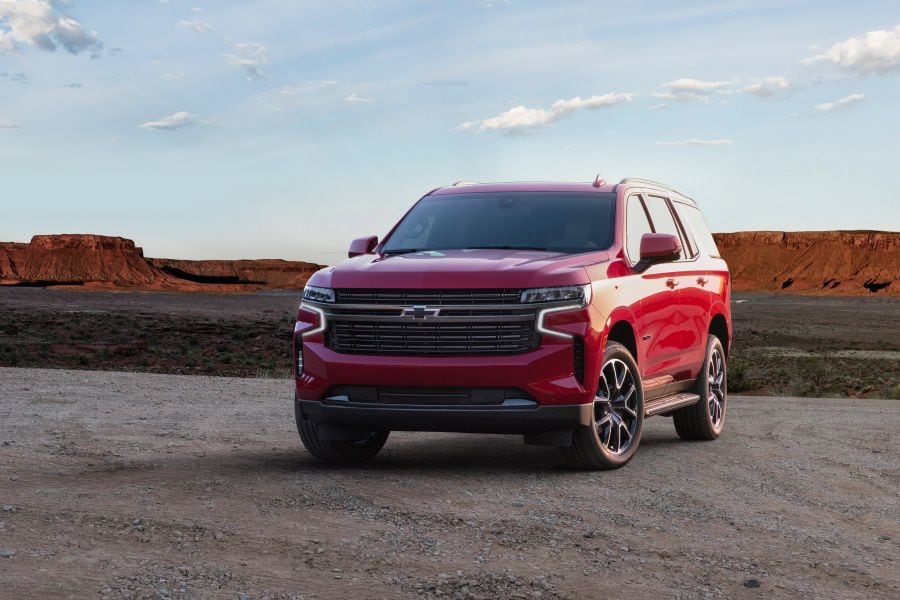
2021 Chevrolet Tahoe RST ・ Photo by Chevrolet
The Chevrolet Tahoe has been the sales leader among traditional three-row SUVs for decades. But for 2022, it has a new challenger: the Wagoneer. This is a name that brings a great deal of Jeep heritage, although it is not officially a Jeep. Of course, it features the distinctive 7-slot grille and carries a lot of Jeep engineering so perhaps one could be excused for calling it the Jeep Wagoneer every once in a while. Naming and branding aside, the new Wagoneer was designed from the ground up to compete with the "big dog" in the full-size SUV hunt, the Chevrolet Tahoe. What the Wagoneer brings to the party is Jeep technology that endows it with serious off-road capabilities. Along with its close sibling, the 2022 Grand Wagoneer, the Wagoneer is shaking up a segment that hasn’t seen many new players. Of course, it should not be forgotten that the Chevrolet Tahoe has markedly improved itself. It got a total makeover for the 2021 model year, so the 2022 has some fresh new tech. And the Chevrolet rides and handles even better than before. The proof is in the driving. Here is the comparison of the 2022 Chevrolet Tahoe and the 2022 Wagoneer.
Exterior Style
Every time the Chevy Tahoe is redesigned, it seems to get bigger, taller, and more imposing. It has to retain its overall length to remain “garageable,” while its brother, the Chevrolet Suburban, is significantly longer. The Wagoneer doesn’t have a big brother — at least not yet — so its designers made it four inches longer and gave it a three-inch longer wheelbase than the Chevy Tahoe. At the same time, the Wagoneer somehow appears a bit more compact than the Chevrolet. Though it grew more imposing with the redesign, the Tahoe still looks like a Tahoe. It is handsome in a conservative manner. The new Wagoneer is equally handsome. It does without some of the bling that characterizes its luxury brother the Grand Wagoneer, and the result is a squared-off, purposeful look.
: Wagoneer
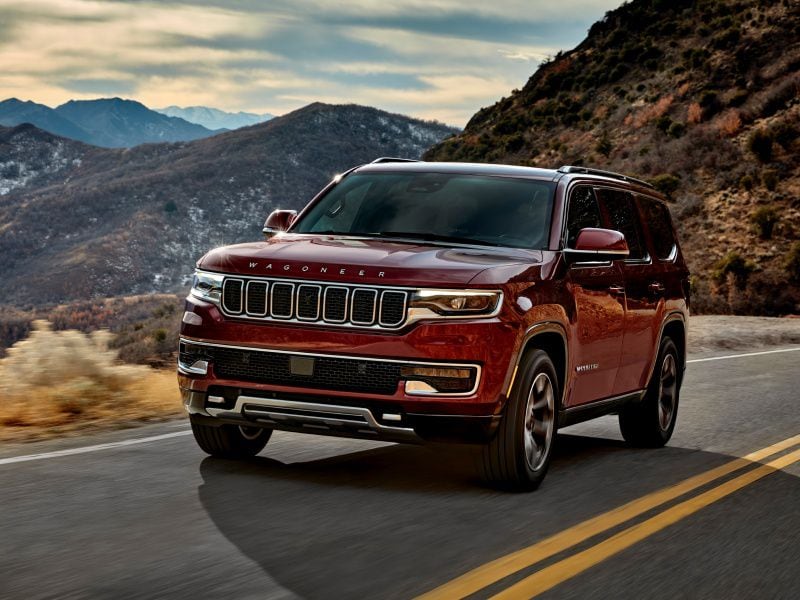
Photo by Jeep
Interior Design
Full-size luxury SUVs like the Grand Wagoneer, Cadillac Escalade, and Lincoln Navigator like to trumpet their opulence. They emphasize ever richer, more luxurious materials and showy design treatments. In contrast, vehicles like the Wagoneer and Chevrolet Tahoe have to appeal to a wider audience. Some are bargain shoppers looking for a big three-row vehicle that can tote their large family, while others don’t mind adding more than a little bling of their own. After all, both vehicles are likely to cost their owners more than $50,000, so some kid-glove treatment is called for. The Wagoneer certainly has plenty of upscale touches to offer, including 12-way power-adjustable leather seats and multizone automatic climate control. The Tahoe can help buyers climb the luxury ladder as well. The base LS at under $50K is pretty utilitarian, but as the trims go upwards, so does the level of luxe. Both the Wagoneer and the Tahoe can seat up to eight occupants. And the third-row seating in both is very comfortable even for full-size adults.
: Wagoneer
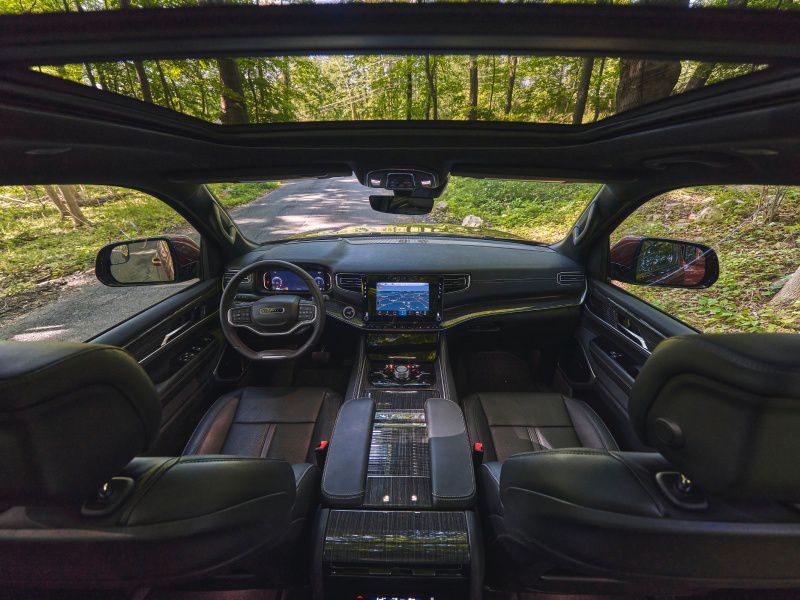
Photo by Jeep
Infotainment & Tech
The Wagoneer’s interior features a whopping 50 inches of combined digital-display screen area. Even though the Grand Wagoneer takes digital displays even further, that’s a pretty impressive number. The 2022 Wagoneer has the most advanced Uconnect system ever, with a 10.1-inch digital display. It uses an Android operating system that facilitates over-the-air updates. Two Bluetooth-enabled phones can be connected to the system at once, and it supports both wireless Android Auto and wireless Apple CarPlay. The system’s Alexa “Home to Car” functionality includes the ability to use the Alexa virtual assistant inside the vehicle and it also includes “Car to Home” features. The Wagoneer also offers the availability of a front-passenger display screen. The Chevrolet Tahoe counters with many similar features. Most models are equipped with a 10.2-inch touchscreen display, and the infotainment system features “Google built-in.” That makes access to Google Assistant, Google Maps, and Google Play seamless. Wireless Android Auto and wireless Apple CarPlay are standard across the board.
: Wagoneer
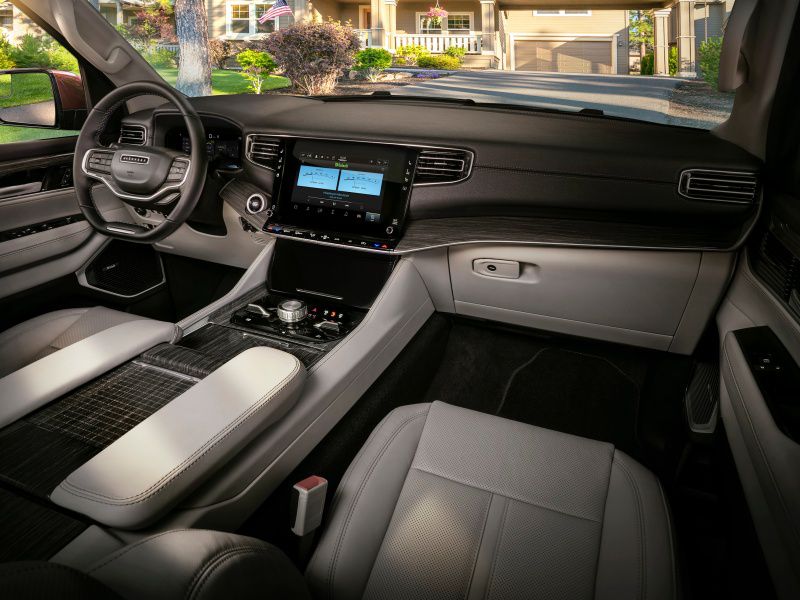
Photo by Jeep
Powertrains
The standard engine in the Wagoneer is Stellantis’s 5.7-liter V8 that delivers 392 horsepower and 404 lb-ft of torque. While a V8 might sound old school, the Wagoneer’s engine features variable camshaft timing, cylinder deactivation, and most important, the newest generation of the eTorque mild hybrid system, which enhances several fuel-saving features. The hybrid powertrain’s motor-generator unit is powered by a 48-volt battery pack to provide quick torque infusions for engine start/stop and during shifts. The engine is teamed with an 8-speed automatic transmission. The Chevrolet Tahoe offers three engine choices — two gasoline V8s and a turbodiesel. The base engine is a 355-horsepower 5.3-liter V8 with cylinder-deactivation technology. A 420-horsepower 6.2-liter V8, also with cylinder deactivation, is optional on some trims. The turbodiesel is a 277-horsepower 3.0-liter inline 6-cylinder that puts out a substantial 460 lb-ft of peak torque. All engines deliver their power through 10-speed automatic transmissions. As with the Wagoneer, both rear-drive and four-wheel-drive versions are available.
: Chevrolet Tahoe
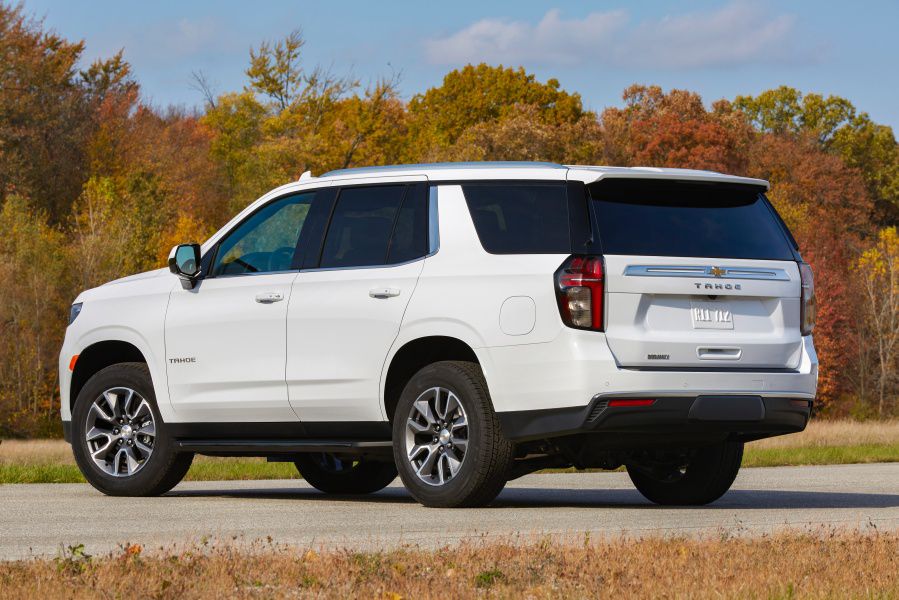
Driving Impressions
Despite the fact that both the Chevrolet Tahoe and Wagoneer are large vehicles that deliver a lot of interior room, they are not the lumbering behemoths you might expect. From behind the wheel, the Wagoneer doesn’t feel as big as the Tahoe even though it is a little bit longer. However, even the Tahoe is fairly light on its feet. One reason for that is the independent rear suspension that came as part of the Tahoe’s redesign. The Wagoneer has real off-road capabilities, but in everyday driving, it feels like a mid-size crossover. Ride quality is excellent, and the Wagoneer tracks well on the highway. All this comes courtesy of the independent double-wishbone suspension. The Wagoneer’s standard coil-spring steel suspension has load-leveling capability, and an air suspension system is available, too. Depending upon the trim, the Chevy Tahoe offers Magnetic Ride Control and the availability of Air Ride Adaptive Suspension. They perform similar magic on the big Chevy’s ride and handling. Both Tahoe and Wagoneer are excellent vehicles for long cross-country drives. We’d choose the Wagoneer for twisty mountain roads and for off-roading.
: Wagoneer
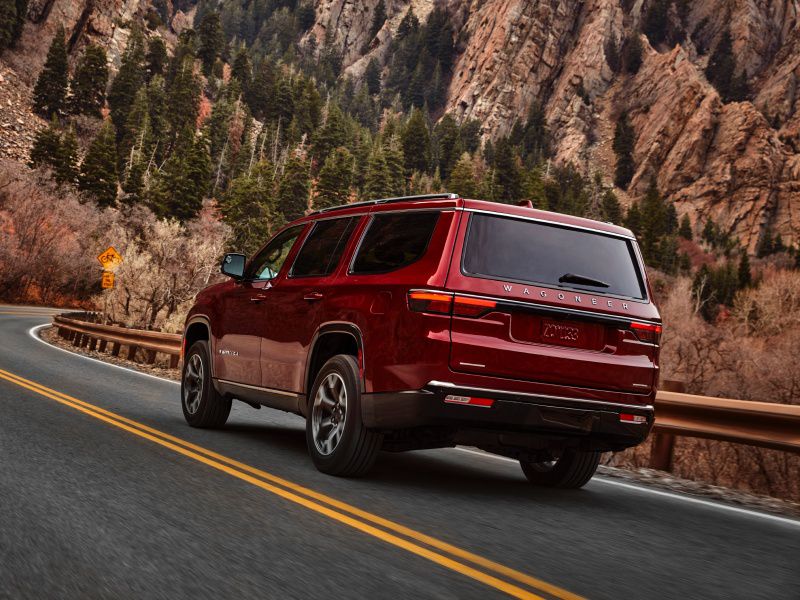
Photo by Jeep
Safety & Driver Assists
The Tahoe and Wagoneer ladle on safety and driver assistance technology because they know families are riding in their vehicles. For 2022, the Chevy Safety Assist array of driver assists is standard on all Tahoes. It includes automatic emergency braking with pedestrian detection, forward collision alert, lane-keeping assist, lane departure warning, following distance indicator, and auto high-beam headlights. Rear pedestrian alert, surround vision camera system and reverse automatic braking are available on some trims. In a similar fashion, the 2022 Wagoneer is also filled with safety and driver assistance technology. Automatic emergency braking with pedestrian and cyclist detection, adaptive cruise control with stop and go, active lane management, blind-spot monitoring, and rear cross-traffic alert are standard on all Wagoneers. Rear parking assist sensors with auto stop and a switch-activated electric parking brake also come standard, while an intersection-collision assist system is an option.
: Wagoneer
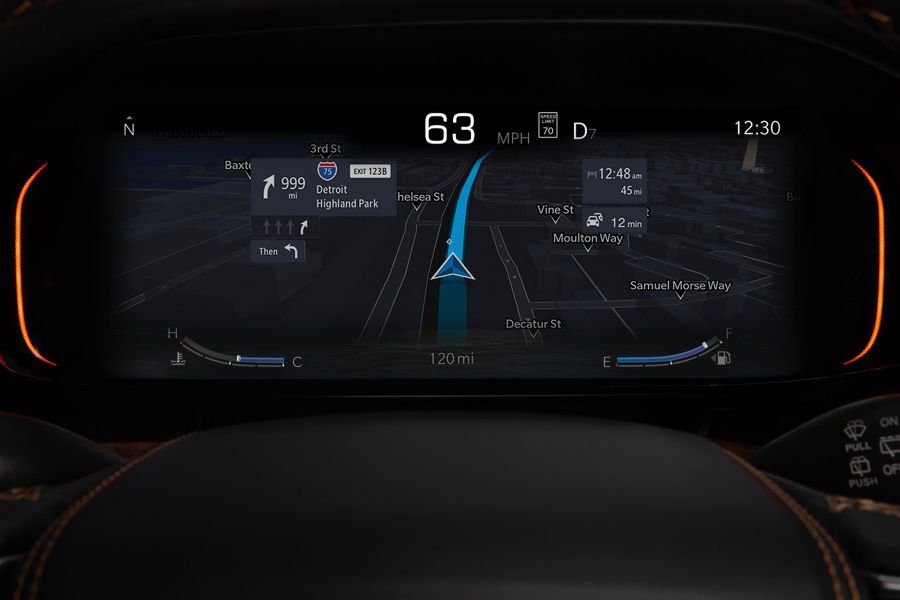
Photo by Jeep
Space, Cargo & Towing
With plenty of interior room for up to eight people, both the Chevrolet Tahoe and the Wagoneer will carry a lot of occupants and their gear. With the rear rows of seats in use, the Wagoneer has 27.4 cubic feet of cargo space. That exceeds the space in the Chevrolet’s massive cargo hold by about two cubic feet. If you fold the third-row seatbacks, the Wagoneer offers 70.8 cubic feet of cargo area, and the Tahoe offers 72.6 cubic feet. And with all seats folded, the Wagoneer’s cargo space jumps to 116.7 cubic feet while the Tahoe pulls ahead with 122.9 cubic feet. Not only will both SUVs accommodate a lot of cargo, but they also have serious towing capabilities. In both four-wheel-drive and rear-wheel-drive forms, the Wagoneer will tow a maximum load of 10,000 pounds when properly equipped. Maximum towing in the various Tahoe models hovers around 8,000 pounds and maxes out at around 8,400 pounds.
: Wagoneer
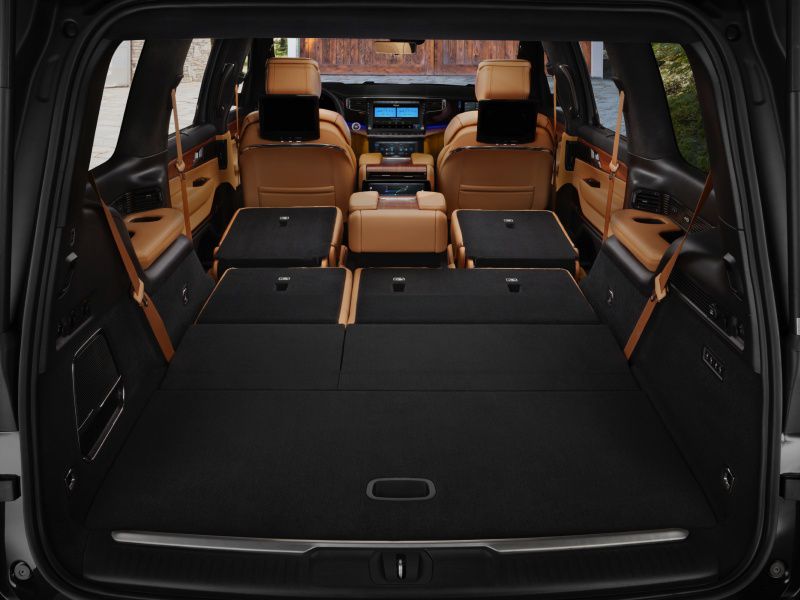
Photo by Jeep
Trim Levels
If you are looking for a variety of trims levels, the Chevrolet Tahoe will be more satisfying than the Wagoneer. The Wagoneer is still in launch phase so some of its variations might be hard to get. Soon it will be available in three different trims — Series I, Series II, and Series III. At launch, Series I vehicles are not available. Both Series II and Series II models are in dealerships in rear-drive and four-wheel drive with the 5.7-liter V8 engine with eTorque hybrid assist. The Series II 4x4 has Quadra-Trac I 4-wheel drive, while the Series II 4x4 has Quadra-Trac II with a 2-speed transfer case. The even more sophisticated Quadra-Drive II is optional. The Chevrolet Tahoe provides more variety. It is offered in six trim levels: LS, LT, RST, Z71, Premier, and High Country. All trims are available with both rear-drive and 4-wheel-drive with the exception of the off-road-oriented Z71. It is 4x4 only. And, as we mentioned, the Tahoe has three powertrain choices — two gasoline V8s and a turbodiesel 6-cylinder.
: Chevrolet Tahoe
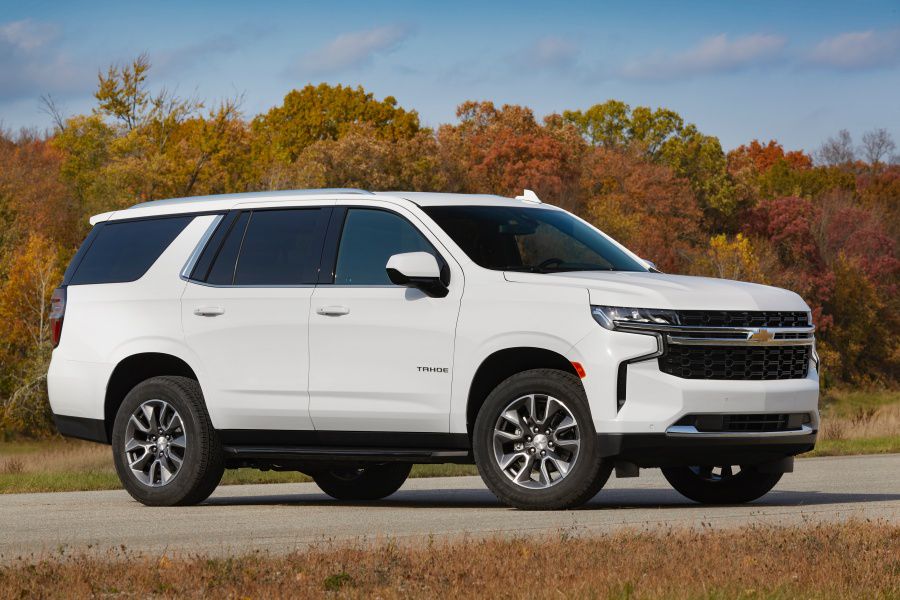
Photo by Chevrolet
Pricing & Value
The 2022 Chevrolet Tahoe can be purchased for a much lower starting price than the currently available Wagoneers. The modestly equipped Tahoe LS has a suggested retail of about $50,000. The Wagoneer Series I will have a starting MSRP of about $58,000 in rear-drive form and $61,000 in four-wheel-drive trim when it becomes available. A rear-drive version of the Series II starts at nearly $70,000 while the four-wheel-drive version bases at about $72,000. A rear-drive Wagoneer Series III has a base price of about $75,000, and the four-wheel-drive model starts at nearly $78,000. In comparison, a rear-drive Chevy Tahoe LT has a base price of around $57,000. The RST starts at around $60,000. And the top-of-the-line Chevrolet Tahoe High Country has a starting price of around $72,000 in rear-drive form. The Tahoe also offers three different engine choices and four-wheel-drive as an option across the lineup.
: Chevrolet Tahoe
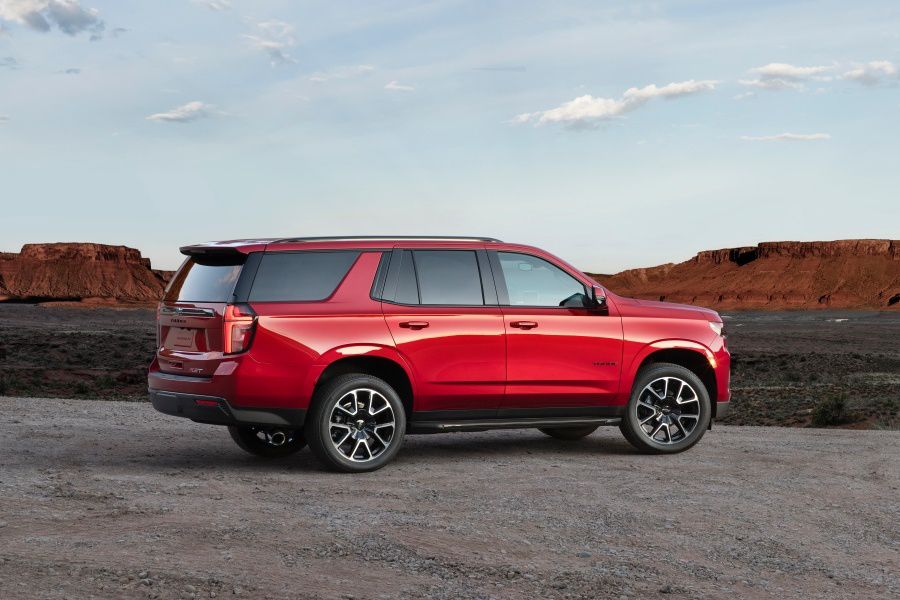
Photo by Chevrolet
The Winner
Choosing a winner between these two excellent vehicles is difficult. Both are very fresh. One — the Chevrolet Tahoe — comes from a line that has dominated the segment for years. It is certainly the high-value choice among full-size SUVs. But then you have the all-new and very enticing Wagoneer. It promises the off-road prowess of its Jeep cousins, and it handles like a smaller vehicle. Both vehicles deliver cavernous interior space and excellent ride comfort. Both are filled with safety and driver aids and impressive technology. In terms of connectivity, these vehicles are close to state-of-the-art. So which one should get the nod? In making the choice, the head is overruling the heart. From a subjective point of view, you could say the Wagoneer is better-looking. But when you consider all the variations the Tahoe brings to the market — from the relatively inexpensive LS to the opulent High Country — and the goodwill the Chevy has engendered through the years, that must color your thinking. So the winner of this comparison is the 2022 Chevrolet Tahoe.
: Chevrolet Tahoe
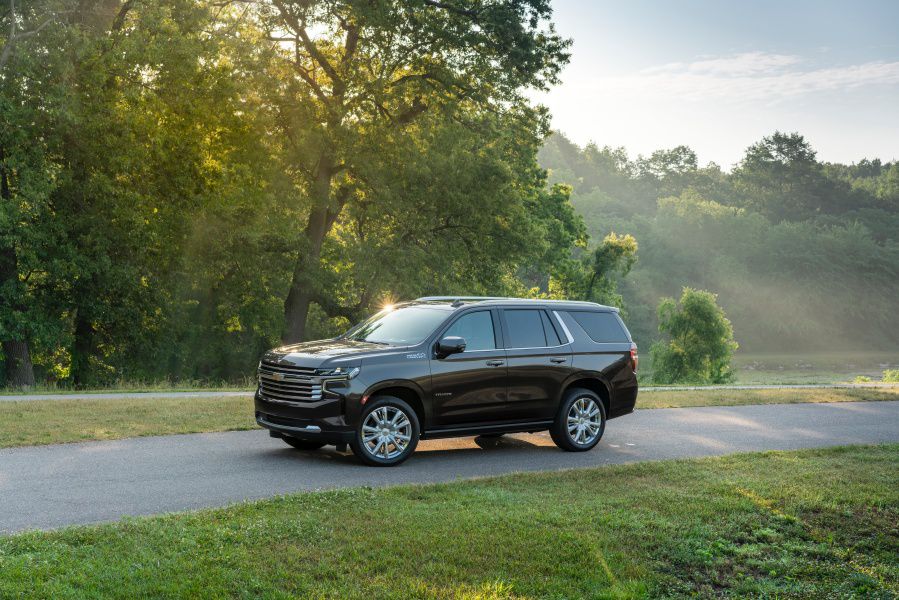
Photo by Chevrolet